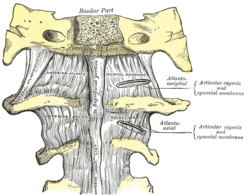| Atlanto-occipital joint | |
|---|---|
 Anterior atlanto-occipital membrane and atlantoaxial ligament. Anterior atlanto-occipital membrane and atlantoaxial ligament. | |
 Posterior atlanto-occipital membrane and atlantoaxial ligament. Posterior atlanto-occipital membrane and atlantoaxial ligament. | |
| Details | |
| System | Skeletal |
| Identifiers | |
| Latin | articulatio atlantooccipitalis |
| MeSH | D001269 |
| TA98 | A03.1.08.001 |
| TA2 | 1630 |
| FMA | 24939 |
| Anatomical terminology[edit on Wikidata] | |
The atlanto-occipital joint (Articulatio atlantooccipitalis) is an articulation between the atlas bone and the occipital bone. It consists of a pair of condyloid joints. It is a synovial joint.
Structure
The atlanto-occipital joint is an articulation between the atlas bone and the occipital bone. It consists of a pair of condyloid joints. It is a synovial joint.
Ligaments
The ligaments connecting the bones are:
Capsule
The capsules of the atlantooccipital articulation surround the condyles of the occipital bone, and connect them with the articular processes of the atlas: they are thin and loose.
Function
The movements permitted in this joint are:
- (a) flexion and extension around the mediolateral axis, which give rise to the ordinary forward and backward nodding of the head.
- (b) slight lateral motion, lateroflexion, to one or other side around the anteroposterior axis.
Flexion is produced mainly by the action of the longi capitis and recti capitis anteriores; extension by the recti capitis posteriores major and minor, the obliquus capitis superior, the semispinalis capitis, splenius capitis, sternocleidomastoideus, and upper fibers of the trapezius.
The recti laterales are concerned in the lateral movement, assisted by the trapezius, splenius capitis, semispinalis capitis, and the sternocleidomastoideus of the same side, all acting together.
Clinical significance
Dislocation
The atlanto-occipital joint may be dislocated, especially from violent accidents such as traffic collisions. This may be diagnosed using CT scans or magnetic resonance imaging of the head and neck. Surgery may be used to fix the joint and any associated bone fractures. Neck movement may be reduced long after this injury. Such injuries may also lead to hypermobility, which may be diagnosed with radiographs. This is especially true if traction is used during treatment.
Additional images
References
![]() This article incorporates text in the public domain from page 295 of the 20th edition of Gray's Anatomy (1918)
This article incorporates text in the public domain from page 295 of the 20th edition of Gray's Anatomy (1918)
- ^ Govender, S.; Vlok, G. J.; Fisher-Jeffes, N.; Du Preez, C. P. (August 2003). "Traumatic dislocation of the atlanto-occipital joint". The Journal of Bone and Joint Surgery. British Volume. 85-B (6): 875–878. doi:10.1302/0301-620X.85B6.14092.
- ^ Wiesel, Samuel; Kraus, David; Rothman, Richard H. (October 1978). "Atlanto-occipital Hypermobility". Orthopedic Clinics of North America. 9 (4): 969–972. doi:10.1016/S0030-5898(20)32207-0. PMID 740387.
| Joints and ligaments of the head and neck | |
|---|---|
| Temporomandibular | |
| Atlanto-occipital | |
